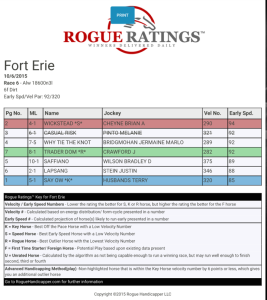Before I took an interest in the sport, I had no idea how much went on behind the scenes at these horse races, specifically when it came to placing bets. While my experience had been big hats, too many mint juleps, and placing a $2 bet on a horse with no clue whatsoever, I had never seen the complicated calculations that went into betting if you wanted to pick a horse based on more than a smart name and dumb luck.
This statistical game is called handicapping, and a lot goes into a handicapping formula.
First, there are the calculations to be done for each individual horse based on their past performances. Some factors that play a role include: how old the horse is, the horse’s average speed/pace around the track, the velocity or consistency of that run, the “early speed” out of the gate, how a horse handles the different track conditions (dirt, turf, firm, sloppy), etc. and a bunch of other things from the horse’s racing record. With so many factors how do you choose? Do you bet on the favorite who comes out of the gate fast and is generally great on a dirt track? Or the horse who runs a consistently good race in any track condition but might not have the fastest early speed to put him as a front runner? Or what about that fresh young face in the competition, does he stand a chance against the older, experienced runners?
But wait, there’s more. After you figure out how each individual horse performs, you have to stack all of those individual statistics against all of the other horses in that race. And, if you are in a contest like I was, you need to do that with every horse, for every run, in every race, for two whole days. You not only need a little luck on your side, you also need some skills… and the players I was competing against were extremely skilled professionals. I didn’t think I stood a chance. I needed some help and Rogue Ratings was the answer to my horse racing guessing game.
 Rogue ratings does all of the handicapping calculations for you and allows you to compete beyond your experience level. The system gives you a breakdown of your smartest bets for each run in the race—color coded and easy to understand.
Rogue ratings does all of the handicapping calculations for you and allows you to compete beyond your experience level. The system gives you a breakdown of your smartest bets for each run in the race—color coded and easy to understand.
There are four possible picks the system will present:
- RED, that’s the *S* Speed horse
- BLUE is the *K* Key horse
- GREEN is a *R* Rogue horse
- YELLOW put its bet on the *FTS* First Time Starter horse
For each race, the calculations of the individual horses are done for you, then stacked up against all of the competitors on the track, and presents you with the best 2-4 picks to play based on the outcome of algorithm. From here it’s up to you to place your final bet based on the results… because we don’t want to take all the fun out of the gamble! But now the questions are simplified dramatically, and it’s just a matter of do we go with the Speed horse (red) or the slightly classier pick, the Key horse (blue).
For more specifics on the differences amongst the four types of horse picks, like what it means to be a Rogue horse, and why the Key horse is a “classier” pick than the Speed horse, along with a crash course to learning the lingo of the horse racing world, look for my next articles on my blog, Going Rogue!










Speak Your Mind